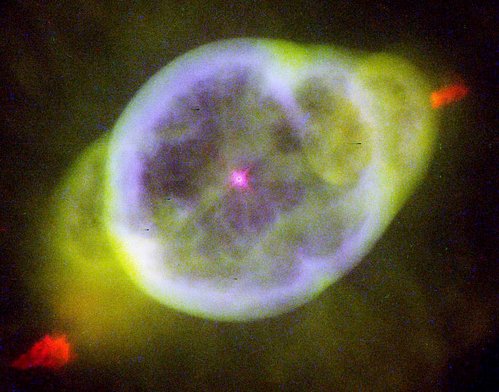Are
all
Greek
lettered
stars
in
the
long
Hydra
constellation
in
my
star
list?
Counting
them
I
find
5 in
the
loop
of
its
head,
then
another
5 in
the
neck
before
Alphard.
Then
there
are
1
(Alphard)
+ 4
before
next
apex
and
a
further
3
before
reaching
Crater.
5 +
5 +
5 +
3 =
18.
To
the
very
bottom
between
Crater
and
Corvus
there
are
5 stars
and
finally
there
are 3
towards
the
end
of
the
tail.
18 +
5 +
3 =
26 -
i.e.
more
than
the
number
of
letters
in
the
Greek
alphabet
(24).
But
there
are
doubles,
τ¹
and
τ²,
υ¹
and
υ²,
χ¹
and
χ².
26 -
3 =
23.
Which
letter
could
be
missing?
| Α α |
Ν ν |
| Β β |
Ξ ξ |
| Γ γ |
Ο ο |
| Δ δ |
Π π |
| Ε ε |
Ρ ρ |
| Ζ ζ |
Σ σ/ς |
| Η η |
2 * Τ τ |
| Θ θ |
2 * Υ υ |
| Ι ι |
Φ φ |
| Κ κ |
2 * Χ χ |
| Λ λ |
Ψ ψ |
| Μ μ |
Ω ω (θ?) |
In the star map above the missing star is θ, but in my astronomy book the star at the neck of Hydra is θ - while instead ω is missing. In rongorongo times this quite special position was 136 days after March 21, i.e. in August 4 (216):
 |
 |
 |
 |
| Ga3-10 |
Ga3-11 |
Ga3-12 |
Ga3-13 (72) |
| M67 (133.1) |
ζ Hydrae (134.1), ρ Cancri (134.2), ο Cancri (134.6) |
Acubens, Talitha Borealis (135.0), σ Cancri (135.2), ρ Ursa Majoris (135.6) |
ν Cancri (136.0),Talitha Australis (136.1), ωHydrae (136.8) |
| August 1 |
2 (580 - 80 = 500) |
3 (215) |
4 (*136) |
| ºJuly 28 |
29 (210) |
30 |
31 (*132) |
| 'July 5 (186) |
6 (*473) |
7 (*108) |
8 |
| Solstice (*92) |
"June 22 (173) |
23 |
St John's Eve |
| μ Aquarii (316.0) |
ε Equulei (317.8) |
no star listed (318) |
21h (319.6) |
| Armus (319.0), Dorsum (319.3), Tsoo (319.7) |
| January 31 |
February 1 (32) |
2 (*318) |
3 (399) |
| ºJanuary 27 (392) |
28 |
29 (*314) |
30 |
| 'January 4 |
5 (*290) |
6 |
7 (372) |
| Solstice (*275) |
"December 22 |
23 (357) |
Christmas Eve |
Or maybe we should instead look at the Full Moon in the night and look for the position at the opposite side of the sky roof, where February 3 marked day 399 = the synodic cycle of Jupiter. NGC 3242 is the Ghost of Jupiter:

"This planetary nebula is most frequently called the Ghost of Jupiter, or Jupiter's Ghost due to its similar size to the planet, but it is also sometimes referred to as the Eye Nebula." (Wikipedia)
I think ω should be the correct letter because when someone dies another person will take over:
| Greek omega |
Ω (ω) |
|
Omega ... is the 24th and last letter of the Greek alphabet. In the Greek numeric system, it has a value of 800. The word literally means 'great O' (ō mega, mega meaning 'great'), as opposed to omicron, which means 'little O' (o mikron, micron meaning 'little') ...
The form of the uppercase letter derives from that of an omicron (Ο) broken up at the side ... with the edges subsequently turned outward:

The modern lowercase shape goes back to the uncial form

a form that developed during the 3rd century BC in ancient handwriting on papyrus, from a flattened-out form of the letter ... that had its edges curved even further upward

Possibly, I think, this flattened out form alluded to the high sky 'carapace' in summer. As to the 'broken up omikron' it could have been turned at is side as an allusion to the orientation of the Gemini pair. The uncial form could reflect a pair of twins joined together (at the star ω Gemini). |
If such is the case, then θ could refer to the view when the old one is in the past:
| Egyptian nfr |
 |
Phoenician teth |
 |
Greek theta |
Θ (θ) |
|
... The form of the letter θ suggests a midline ('waist'), although the origin of θ is the Phoenician tēth which means 'wheel'. This in turn could have originated from a glyph named 'good' which in Egypt was nfr ...
... θ is the last star in the Ara constellation, and the ancient meaning of this letter was described as a wheel by the Phoenicians but for the Egyptian it meant 'good'. When the wheel of time has come full cycle around and the upside down fire-altar is in the past the times ahead should be good (or lucky Sa'ad) ... |
|


